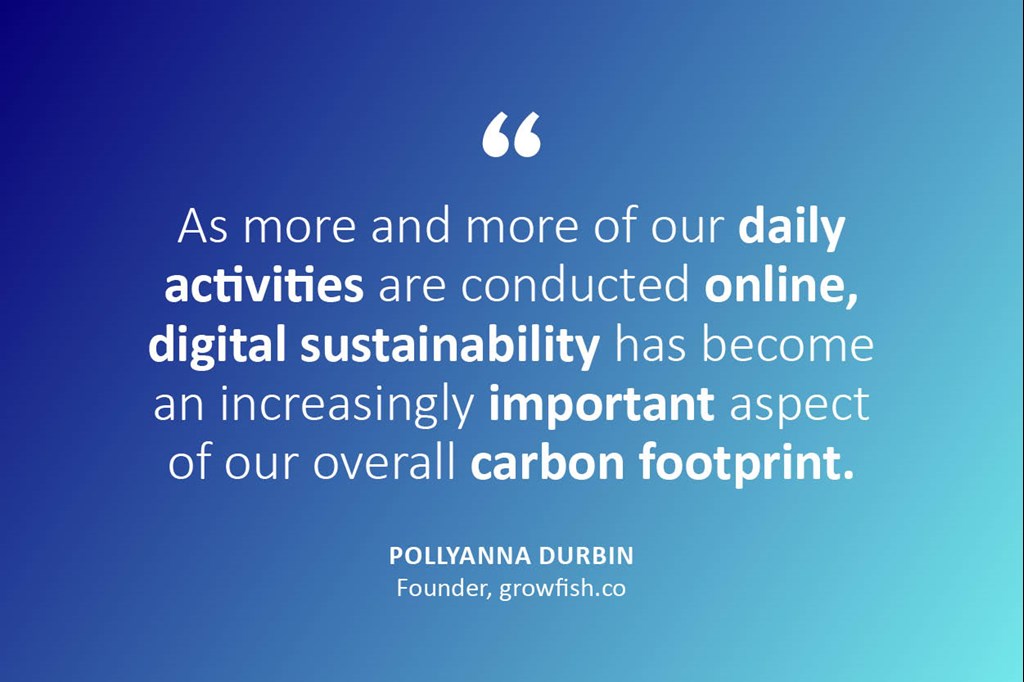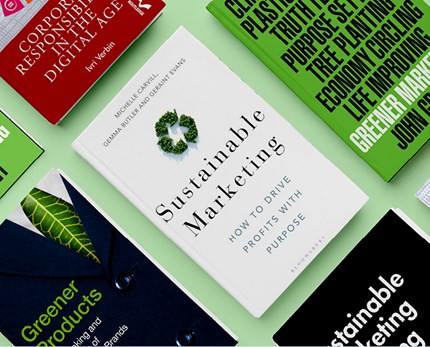Marketing and your digital carbon footprint: Where to begin

- 10 March 2023
Marketers and businesses are seeing the value and importance of incorporating sustainability within their strategy, but what about your business’ digital carbon footprint? In this article, CIM’s Laura Scott reveals what she learned and shares expert tips from the founder of sustainable marketing and comms agency Growfish.co, Pollyanna Durbin.
CIMs inaugural Sustainability Summit’s stage was filled to the brim last year, with speakers and organisations sharing their secrets to achieving a successful sustainability strategy. Watch our exclusive clip from the Q&A panel session to discover their thoughts on the lesser spoken-about, digital carbon footprint.
What is a digital carbon footprint?
“A digital carbon footprint is the amount of greenhouse gases that are emitted as a result of the production, use, and disposal of digital devices as well as the energy that is used to power them. This includes emissions from manufacturing and the energy used to run data centres”
- Pollyanna Durbin, founder, Growfish.co.
Our carbon footprint is easily recognisable in our daily lives. From the emissions emitted from our cars to the materials that can or can’t be recycled in our bins. However, your digital carbon footprint could be something you haven’t considered before.
From a marketer’s perspective, this can be the energy expelled from sending emails, or servers designed for data far in excess of what you produce.
Why your digital carbon footprint is important for your customers, your business and the planet
The Energy and cost-of-living crisis
“By harnessing the power of smart and digital technologies we can modernise our energy system, helping improve customer experiences and deliver a net-zero future.”
- Energy and Climate Change Minister, Greg Hands.
Both consumers and businesses are seeing the effects of the cost-of-living crisis. According to a government report, “Millions of UK households are set to see their energy bills surpass £2,000 […], largely due to the skyrocketing costs of gas imports. At the same time, food prices are rising and changes to income tax could leave many low and middle-income homes paying up to £3,000 extra annually.”.
So, it’s never been more vital for your business to conserve energy and reduce energy costs.
In the foreword to a recently released policy paper, UK Prime Minister, Rishi Sunak promised that The Department for Energy Security and Net Zero will focus on providing “cheaper, cleaner, more secure sources of energy – cutting bills, [and] cutting emissions.”.
Sustainable marketing strategy
“As more and more of our daily activities are conducted online, digital sustainability has become an increasingly important aspect of our overall carbon footprint.”
- Pollyanna, founder, Growfish.co
You don’t need to begin overhauling every aspect of your business in one go to implement a sustainable marketing strategy, you just need to start. There are many ways to do this and educating yourself and your team is a great starting off point.
For example, optimising your SEO can benefit your business in more ways than one. Improving your business’s visibility means that consumers spend less time searching and scrolling. Resulting in less energy being used and carbon being emitted.
Brands are increasingly levelling up their sustainable marketing strategies, and having a recognisable symbol that consumers can recognise to aid their buying decisions. Part of this is leading organisations to work towards certifications, such as acquiring a B Corp certification.
Customer buying decisions
In the last five years, 90% of customers have chosen to make more sustainable choices and this places organisations under pressure to demonstrate how they are being sustainable. Including how they communicate with their customers.
During CIM’s Live Podcast, Innocent Drinks UK’s Emilie Stephenson, and Mintel’s Richard Cope, spoke about how consumer buying behaviour impacted everything from product to campaign.
The data from Mintel’s Sustainability Barometer revealed that although consumers are making more sustainable choices, overall, they believe that the responsibility for sustainability lies with the government and brands.
Regulation
The UK government has committed to reducing greenhouse gas emissions by at least 100% of 1990 levels (Net zero) by 2050. As advised by CCC’s 2019 report, ‘Net Zero – The UK’s contribution to stopping global warming’.
As well as the ASA keeping advertisers accountable for their sustainability claims, the UK government has set out the Green Claims Code.
“The purpose of this guidance is to help businesses understand and comply with their existing obligations under consumer protection law when making environmental claims.” - Competitions and Marketing Authority, 20 September 2021.
Adhering to the regulations can mean all the difference to avoid claims of greenwashing and negative headlines. Recently, Lufthansa’s advert was banned in the UK for misleading customers on their ‘green claims’ and as the ASA calls for stricter regulation, this scrutiny is only going to intensify in 2023.
You can find out more about the Green Claims Code and how it works via the CIM Webinar on demand, ‘Green Claims Code: What you need to know”.
How you can start to reduce your digital carbon footprint today
Pollyanna Durbin, founder of Sustainable marketing and comms agency Growfish, shared some of her top tips to help you get started.
1. “Reduce excessive digital communication”
Communication, naturally, is an important part of any business and research shows that 59% of people prefer to be contacted by brands via email. There are an estimated 333 billion emails sent per day, across the planet and it makes sense when you think of the power of email for businesses. However, although there isn’t any printing on paper or a postal van involved, there is still a carbon footprint. When you also include sound or video, it can notably increase.
The trick isn’t to stop using email but use it when necessary and with purpose. Saving you time, money and resources.
2. Reduce your device usage and “use energy-efficient devices”
“A plugged-in device will still use electricity even when it's on standby [...] When you do need to purchase new devices, look for those that are Energy Star certified or have a high energy efficiency rating.”
- Pollyanna, founder, Growfish.co
As the old adage goes, “this meeting could have been an email” and it's good practice to ask questions about how sustainable your processes are. Such as, if the printer is only used once a day, perhaps unplug it when it’s not in use. Or when you go on a lunch break, shut down your computer, rather than leaving it on standby.
Implementing these small changes and purchasing energy-efficient devices will then help to reduce your digital carbon footprint, and your energy usage.
3. “Choose eco-friendly providers”
“When choosing internet and cloud service providers, look for those that are committed to renewable energy and energy efficiency.”
- Pollyanna, founder, Growfish.co
H&M group, for example, have completed two solar projects in Leicestershire, which will source renewable electricity. Transport for London (TFL) has also launched a tender for a Power Purchase Agreement (PPA) to help meet 10% of their annual usage.
4. Video calls
“Video conferencing calls: Only keep video on when absolutely necessary during meetings, otherwise turn it off and switch to audio. According to Forbes, turning off your camera in video calls could cut carbon emissions by 96%.”
- Pollyanna, founder, Growfish.co
A report released by the Resources, Conservation and Recycling journal in 2021, revealed that an hour of videoconferencing can emit 150-1000 grams of carbon dioxide, needs 2-12 litres of water and a small amount of land just smaller than the size of your laptop.
So, turning your camera off, or streaming content in standard rather than high definition, can help reduce your carbon, water and land footprint.
5. “Recycle or dispose of devices responsibly”
“When you're finished with a device, make sure to recycle or dispose of it responsibly. Many electronics recyclers will properly handle the disposal of your device, including properly disposing of toxic materials.”
- Pollyanna, founder, Growfish.co
According to a report released by Material Focus, at least 108,000 tonnes of business electricals are being recycled through Approved Authorised Treatment Facilities (AATFs). However, their findings also revealed that up to 200,000 tonnes are added to general waste, and up to 109,000 tonnes are being processed at scrap metal processors, instead of AATFs, resulting in valuable materials aren’t being recycled.
Involving your entire team
Committing to developing more sustainable practices is something you can get the whole business involved in, where everyone in your team can make a positive impact. According to the findings of CIM’s Sustainability marketing skills gap report, 45% of marketers feel under pressure to communicate their company or clients’ sustainability credentials. And 40% don’t currently have sustainable marketing qualifications but are interested in gaining one.
From filling the sustainability skills gap in your business to the font you use on your website and avoiding greenwashing claims, there are plenty of ways to make your brand sustainable.
Nurture your business with the plethora of resources on our Sustainable Marketing Hub and fortify your sustainability skills with our Sustainability qualifications and training courses.

Tags:
- 0 views

 FAQs
FAQs
 Log in
Log in
 MyCIM
MyCIM







